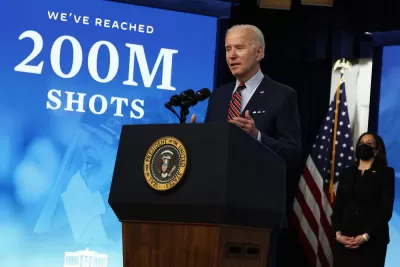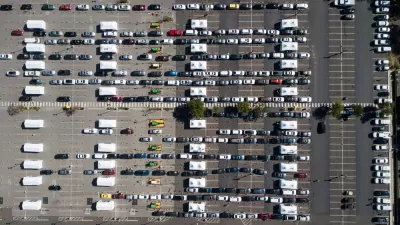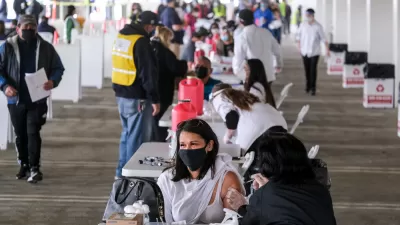The 'light at the end of the tunnel' has become brighter after the vaccination rate tripled since President Biden took office. According to an analysis, a vaccination enthusiasm tipping point will be reached in 2-4 weeks that could dim the light.

"Today, we hit 200 million shots on the 92nd day in office," stated President Joe Biden in a speech from the White House on April 21 marking the second vaccination target his health team has met in the administration's first 100 days.
You know, at the pace we were moving when I took office, it would have taken us more than 220 days — almost seven months — seven and a half months — to reach 200 million shots. Instead of marking this milestone in April, we would not have seen it until early September at the earliest.
Now that we’ve reached this milestone, we’re entering a new phase of our vaccination effort. As of Monday, at my direction, with the support of 50 governors — Democrats and Republicans, alike — everyone over the age of 16 will be [is now] eligible to get vaccinated.
The eligibility milestone was also noted by the Kaiser Family Foundation, a nonprofit organization focusing on national health issues, in an analysis of vaccine supply and demand released on Tuesday (source article).
Now, with supply having increased significantly and eligibility fully open to adults in all states as of April 19, the main question has become, when will supply outstrip demand?
While timing may differ by state, we estimate that across the U.S. as a whole we will likely reach a tipping point on vaccine enthusiasm in the next 2 to 4 weeks. Once this happens, efforts to encourage vaccination will become much harder, presenting a challenge to reaching the levels of herd immunity that are expected to be needed.
The analysis is partly based on the extensive and detailed polling by the foundation on demand for the COVID-19 vaccines.
"Federal, state, and local officials, and the private sector, will face the challenge of having to figure out how to increase willingness to get vaccinated among those still on the fence, and ideally among the one-fifth of adults who have consistently said they would not get vaccinated or would do so only if required," write Jennifer Kates, Larry Levitt, and Josh Michaud of the foundation.
Politico also noted the upcoming vaccine challenge in their report on the president's speech.
"The [president's] announcements come as the administration is reaching a new turning point in its campaign to vaccinate over 300 million Americans: Supply is beginning to exceed demand, and appointments are going unfilled in both rural areas and big cities," wrote Quint Forgey and Rachel Roubein.
The problem goes beyond vaccine hesitancy and extends to Americans who have neither easy access to the shot nor the motivation to get vaccinated. State and federal officials say the focus is now on meeting people where they are.
Grant County, Oregon
What the Kaiser Family Foundation predicts will soon happen nationwide is already occurring in Oregon's coronavirus hotspot. The state is seeing a surge in new infections. The Washington Post coronavirus database shows a 27% increase in cases during the last week, although case incidence, 16 per 100,000 people, remains below the national average of 19 per 100k, on April 22.
Upon closer look at the Beaver State, Grant County has the most severe outbreak. Case incidence is 147 per 100k for the county of 7,200 people, according to Covid Act Now. The next highest is Klamath County, pop. 68,000, at 51 per 100k. By comparison, the nation's hotspot, Michigan, has 64 per 100k.
The local paper, the weekly Blue Mountain Eagle, observed on April 13 that the county last week "had the highest rate of COVID-19 infections per capita in Oregon, and the county also has the worst vaccination rate in the state."
"On Sunday [April 11], Kimberly Lindsay, Grant County public health administrator, estimated that around 30% of the county’s residents are partially or fully vaccinated," reported Steven Mitchell. "Lindsay said the county has stopped requesting additional vaccine doses from the Oregon Health Authority because of a lack of demand."
Greg Armstrong, the owner of Len’s Drug, told the Eagle they have more doses at the pharmacy than people coming in to getting the shot.
“I am very concerned,” Lindsay said. “With 70% unvaccinated, that leaves just over 5,000 people available for COVID-19 to move through freely. That’s a lot of room to roam.
Related in Planetizen:
-
Pandemic Endgame: The Goalposts are Moving, December 30, 2020
FULL STORY: Supply vs Demand: When Will the Scales Tip on COVID-19 Vaccination in the U.S?

Alabama: Trump Terminates Settlements for Black Communities Harmed By Raw Sewage
Trump deemed the landmark civil rights agreement “illegal DEI and environmental justice policy.”

Study: Maui’s Plan to Convert Vacation Rentals to Long-Term Housing Could Cause Nearly $1 Billion Economic Loss
The plan would reduce visitor accommodation by 25% resulting in 1,900 jobs lost.

Why Should We Subsidize Public Transportation?
Many public transit agencies face financial stress due to rising costs, declining fare revenue, and declining subsidies. Transit advocates must provide a strong business case for increasing public transit funding.

Paris Bike Boom Leads to Steep Drop in Air Pollution
The French city’s air quality has improved dramatically in the past 20 years, coinciding with a growth in cycling.

Why Housing Costs More to Build in California Than in Texas
Hard costs like labor and materials combined with ‘soft’ costs such as permitting make building in the San Francisco Bay Area almost three times as costly as in Texas cities.

San Diego County Sees a Rise in Urban Coyotes
San Diego County experiences a rise in urban coyotes, as sightings become prevalent throughout its urban neighbourhoods and surrounding areas.
Urban Design for Planners 1: Software Tools
This six-course series explores essential urban design concepts using open source software and equips planners with the tools they need to participate fully in the urban design process.
Planning for Universal Design
Learn the tools for implementing Universal Design in planning regulations.
Smith Gee Studio
Alamo Area Metropolitan Planning Organization
City of Santa Clarita
Institute for Housing and Urban Development Studies (IHS)
City of Grandview
Harvard GSD Executive Education
Toledo-Lucas County Plan Commissions
Salt Lake City
NYU Wagner Graduate School of Public Service




























